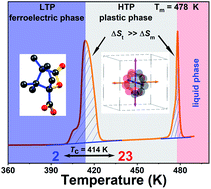An organic plastic ferroelectric with high Curie point†
Abstract
Plastic ferroelectrics, featuring large entropy changes in phase transitions, hold great potential application for solid-state refrigeration due to the electrocaloric effect. Although conventional ceramic ferroelectrics (e.g., BaTiO3 and KNbO3) have been widely investigated in the fields of electrocaloric material and catalysis, organic plastic ferroelectrics with a high Curie point (Tc) are rarely reported but are of great importance for the sake of environmental protection. Here, we reported an organic plastic ferroelectric, (−)-camphanic acid, which crystallizes in the P21 space group, chiral polar 2 (C2) point group, at room temperature. It undergoes plastic paraelectric-to-ferroelectric phase transition with the Aizu notation of 23F2 and high Tc of 414 K, showing large entropy gain (ΔSt = 48.2 J K−1 mol−1). More importantly, the rectangular polarization–electric field (P–E) hysteresis loop was recorded on the thin film samples with a large saturated polarization (Ps) of 5.2 μC cm−2. The plastic phase transition is responsible for its multiaxial ferroelectric feature. This work highlights the discovery of organic multiaxial ferroelectrics driven by the motive of combining chirality and plastic phase transition, which will extensively promote the practical application of such unique functional materials.



 Please wait while we load your content...
Please wait while we load your content...